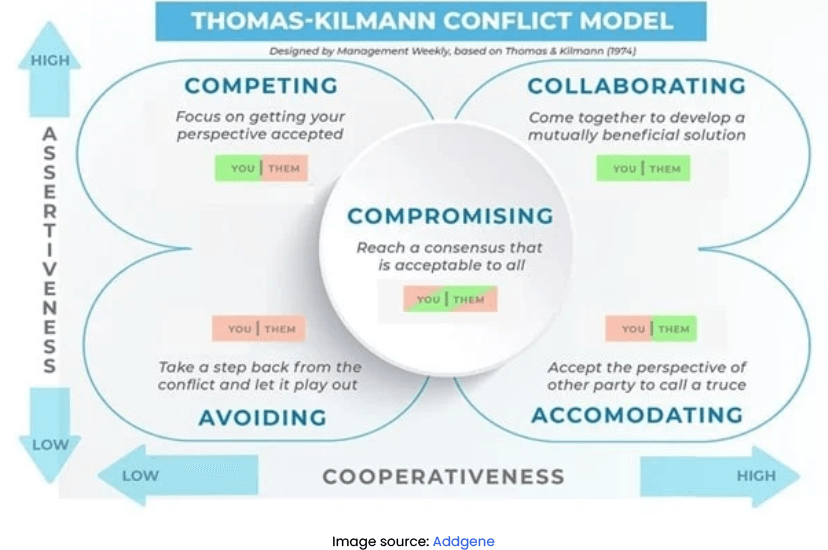
Click the button to start reading
9 Internal Conflict Examples at the Workplace and How You Can Handle Them
You feel trapped in a never-ending tug of war. You keep on asking yourself: “Should I put myself first or focus on work?”
It’s a crucial question that demands your attention before things get worse.
But even if you haven’t reached that extreme point, you might still be facing internal conflict that shouldn’t be ignored.
Get ready to explore internal conflict examples and understand how they affect both employees and the company. Wanna tackle these issues head-on? Grab the top strategies to resolve conflicts effectively and bring back the harmony your team deserves.

What Is an Internal Conflict?
An internal conflict is when a person feels torn inside because of opposing thoughts or emotions.
For example, you could doubt yourself or feel uncertain about your choices. Also, you might struggle with doing what you know is right versus going for what benefits you the most. Another common conflict is wanting to change your life but being afraid of what might happen if you do.
In a workplace, these inner struggles can affect how well you do your job and how you get along with your coworkers. When you’re dealing with these conflicts, it can be hard to concentrate and work well with your team. Besides, if you don’t resolve these issues, they can make you feel more stressed and less productive.
Revealing Workplace Conflict Statistics: A Closer Look
Workplace conflict isn’t only a common issue. It’s an expensive problem that affects businesses worldwide. In the United States, for example, employees spend about 2.8 hours each week dealing with conflicts at work.
What’s more, 85% of both employees and leaders admit that they experience some level of conflict in their workplaces. It’s a good indicator that this issue affects everyone in the organization.
Finally, the financial impact is huge, with businesses losing $359 billion each year due to workplace conflicts. As a result, it has an impact on productivity, employee morale, and company performance.
Without a doubt, companies need to address internal conflicts proactively. This will ensure a harmonious and productive work environment for everyone.

Real-Life Internal Conflict Examples in the Workplace
Now, let’s take a look at some examples of internal conflict at work:
Promotion Dilemma. Two colleagues with similar qualifications and experience both apply for a promotion. As a result, the hiring manager faces an internal conflict in choosing one candidate over the other.
Personality Clashes. Two employees have personalities that clash. There are disagreements and tension whenever they have to work together on a project.
Resource Allocation. Two departments are fighting over how to divide a limited amount of the budget. Each team thinks their projects should get the most money, and they don’t want to give up.
Workload Distribution. Team members feel that one member isn’t pulling their weight. This creates resentment and frustration among the rest of the team.
Ethical Dilemma. An employee is torn between following a directive that conflicts with their personal values. For example, an employee is asked to lie to a client to secure a deal, but honesty is one of their core values.
Office Politics. Rivalry and competition for a promotion or recognition create internal conflicts. Team members are all trying to get the same opportunities, but they don’t feel they’re treated equally.
Communication Breakdown. Who is supposed to do what? When is the deadline? Who is responsible for the pending tasks? Miscommunication or lack of communication among team members often results in misunderstandings.
Resistance to Change. Some employees resist implementing new technology or process changes. And those who believe changes are necessary for improvement may find themselves in a conflict.
Performance Evaluation Disputes. Disagreements can arise when employees receive feedback or evaluations they feel are unfair or biased.
These internal conflict examples show the different tensions that can happen at work. If you ignore them, they can get worse and cause bigger problems later on.

How Do Internal Conflicts Impact Company Culture?
Even small conflicts can have a big impact on company culture, sending ripples throughout the entire workplace. Here are some ways in which internal conflict examples can influence company culture:
Loss of Trust. Internal conflicts damage trust among team members and between employees and management. A lack of trust can lead to a breakdown in communication and cooperation. This, of course, can hinder the organization’s ability to achieve its goals.
Fear of Speaking Up. When employees have problems inside themselves, they might feel scared to speak up and share their thoughts. And there are good reasons why. They worry about what might happen if they do, like getting in trouble or getting caught up in the conflicts themselves.
Impact on Employee Engagement. A culture riddled with internal conflicts can decrease employee commitment to the company. Disengaged employees are less likely to be productive. Very soon, they’ll start looking for an excuse to leave the organization.
Turnover and Retention Issues. A negative company culture driven by internal conflicts can lead to higher employee turnover. Talented individuals seek healthier work environments elsewhere. And top-notch companies will undoubtedly consider their candidacy.
Difficulty in Recruiting. Word about a company’s negative culture can spread really fast. This makes it challenging to attract top talent and affects the company’s ability to recruit skilled employees.
Ineffective Leadership. A company culture that tolerates or ignores internal conflicts can damage leadership credibility. Leaders may be seen as ineffective or incapable of addressing critical issues.
Lack of Collaboration and Innovation. In a culture marred by internal conflicts, collaboration and teamwork suffer. Employees may become reluctant to share ideas, limiting innovation and creativity.
Dealing with Conflict: The Thomas-Kilmann Conflict Model
Next time you find yourself in the midst of a conflict, remember the Thomas-Kilmann Conflict Model to choose your approach wisely.
The Thomas-Kilmann Conflict Model is a helpful tool that can help you navigate the tricky waters of conflict.

So, picture this: you find yourself in a disagreement with someone, and tensions start to rise.
This model, developed by K. Thomas and R. Kilmann, introduces us to five different conflict-handling styles. Each style reflects our varying approaches when faced with conflict. Let’s explore these styles and how they can help us navigate the complexities of conflicts in our daily lives.
Let’s break it down:
Competing (I Win, You Lose). When you find yourself in a situation where you focus on your own needs and goals over others’, that’s the competing style. It’s like a fierce game where you aim to come out as the winner.
Collaborating (We Both Win). In the collaborating style, you strive to find a win-win solution. It’s all about working together as a team and reaching a solution for everyone involved.
Compromising (A Bit of Both). Sometimes, we need to find a middle ground. That’s where the compromising style comes in. You and the other person make small changes to reach a solution that both sides feel okay with.
Avoiding (I’ll Deal with It Later). If you’d rather avoid confrontation altogether, that’s the avoiding style. You might put off the conflict, hoping it’ll resolve on its own or choosing to walk away from the situation entirely.
Accommodating (You Win, I Lose). Lastly, there’s the accommodating style, where you prioritize the other person’s needs over your own. You might make sacrifices to keep the peace or keep a positive relationship.

9 Internal Conflict Examples at Workplace with Useful Resolutions
First, make a note of this: resolving internal conflicts isn’t just about finding a quick fix. It’s about building a supportive work environment. If you care for your team, you’ll create a happy environment where conflicts are handled well, and relationships thrive.
1. Communication Issues
Conflict: Poor communication leads to misunderstandings and conflicts among team members.
Solution: First, set up internal communication strategies. Next, have regular team meetings and encourage open communication. This will improve information sharing and prevent misunderstandings. Plus, training sessions on effective communication skills can help everyone develop positive habits.
Find out if technology can help. Bring in the right tools to prevent misunderstandings. A team management tool, like Teamly, will help you streamline workflows and improve team communication. From video chats to direct messages, screenshots, and screen videos, Teamly ensures everyone is on the same page.
2. Decision Disagreement
Conflict: Team members have conflicting opinions on a business decision, leading to deadlock and delays.
Solution: Set aside time for open discussions. Make sure everyone feels free to share their thoughts without fear of judgment. Use techniques like brainstorming or voting to find common ground and make decisions. If needed, a selected leader can make the final decision, considering the team’s input. This way, everyone will understand the reasons behind the choice.
Another helpful technique is to create team charters. These help to build a common understanding among team members and stakeholders. Once you clarify the team’s direction and priorities, you improve the sense of unity, commitment, and accountability.
3. Clash of Personalities
Conflict: Two employees with different personalities clash frequently. This gives rise to many internal conflict examples and affects collaboration.
Solution: To address conflicts between team members, it’s important to act promptly and directly. Start by having constructive conversations to help them see each other’s perspectives. Meanwhile, you can organize team-building activities led by the HR department or team leader. If you can organize individual coaching or conflict mediation sessions, that’s even better! These can help employees identify their differences and discover ways to collaborate effectively. In some cases, it might be best to cut direct contact between individuals with conflicting personalities. This could mean reorganizing teams or adjusting roles for an improved work environment.
4. Competing for Limited Resources
Conflict: Two teams or departments are competing for the same limited resources, such as funding, staff, or equipment.
Solution: Form a resource allocation committee with representatives from different teams or departments. This committee will look into the needs of each group and manage conflicting priorities. The main goal here is to make fair decisions about resource distribution. Don’t forget to set clear guidelines and criteria for allocating resources. This will reduce conflicts and set clear expectations.
5. Uneven Workload
Conflict: Team members feel that the workload isn’t evenly distributed, leading to resentment and stress.
Solution: Your team’s well-being is vital. So, be mindful of their stress levels and workloads, ensuring a healthy work-life balance. Providing support during challenging times can prevent conflicts caused by burnout or frustration.
The team leader can check how much work each person has to make sure it’s fair. If some team members have more work because of their skills or roles, the leader can appreciate their efforts and help them when needed. The leader can also talk to the team regularly to listen to their worries and make changes if needed.
6. Role Ambiguity Conflict
Conflict: Employees are unclear about their roles and responsibilities, leading to confusion.
Solution: The team leader or manager can hold regular meetings to clarify individual roles. Writing down a job description or role outline for each job can also help make things clearer. Team members should feel free to talk and ask questions about their roles whenever needed.
Above all, when faced with internal conflicts, take the time to truly understand what’s going on. Identify the root causes and underlying issues together with the involved parties. Besides, listen actively to each person’s viewpoint. Give everyone a chance to express their concerns, creating an atmosphere of openness and trust.
7. Conflict over Recognition and Rewards
Conflict: You may come across internal conflict examples if employees feel that their hard work isn’t recognized. Of course, this causes dissatisfaction and low morale.
Solution: Make your team feel valued by asking for their feedback. Create opportunities for open discussions about potential issues. Take action based on their feedback to address any underlying concerns. Besides, having a formal program to recognize and reward employees’ hard work can make a big difference. The program should be fair and based on clear standards, like how well they perform, the goals they reach, or the extra effort they put in. Regular feedback (and appreciation) from supervisors can also boost everyone’s spirits. Plus, recognizing each other’s efforts within the team can create a positive work culture.
8. Cultural or Diversity Conflict
Conflict: Misunderstandings and conflicts arise among employees from diverse cultural backgrounds. These can be due to different norms, values, and communication styles.
Solution: To resolve this, you can offer training on cultural sensitivity. This training will help people understand and appreciate different cultures. What’s more, you can come up with engaging activities to build and promote diversity in your team. So, you create an inclusive work environment where everyone’s unique perspectives are valued. In this case, even people from different backgrounds will work together more effectively.
9. Avoiding Change
Conflict: Some employees aren’t happy about using a new process or technology, but others are supportive of the change.
Solution: The company can make a plan to manage the change better. They should clearly explain the benefits and goals of the change. Also, involving employees in the decision-making and talking about their worries can help them feel more on board. Offering support to help employees adjust to the change can also reduce resistance and make the transition smoother.
Let’s Wrap It Up!
When those pesky internal conflicts pop up, remember to put on your detective hat! Take the time to understand what’s going on, dig deep into the causes, and involve all the parties.
You can then create a trusting space because everyone deserves a chance to share their concerns. By tackling these challenges together, you can build a team that’s stronger and more united.
So, use these internal conflict examples as opportunities for growth. And you’ll make your workplace shine with positivity and collaboration!
















